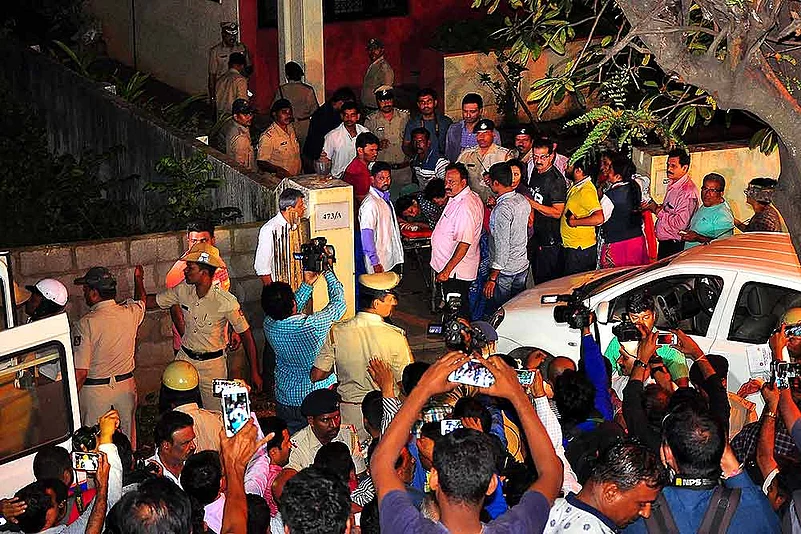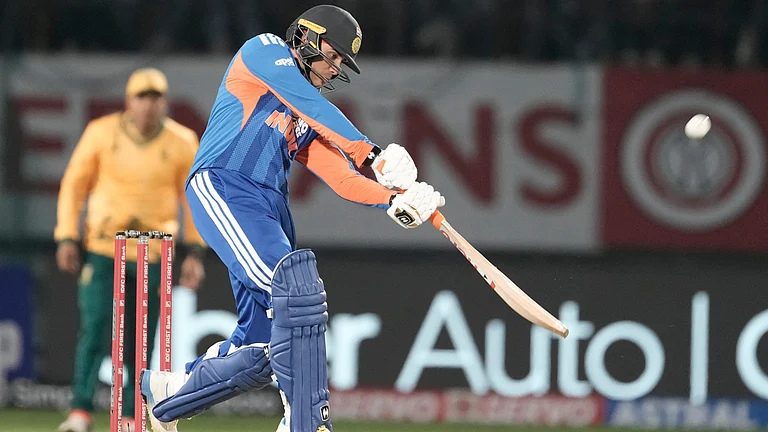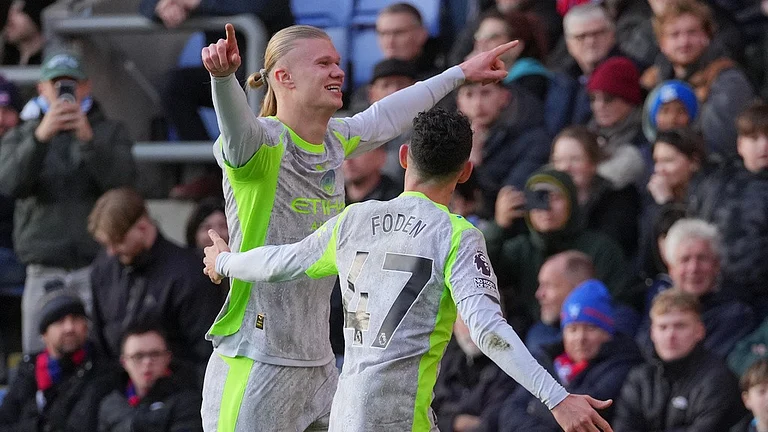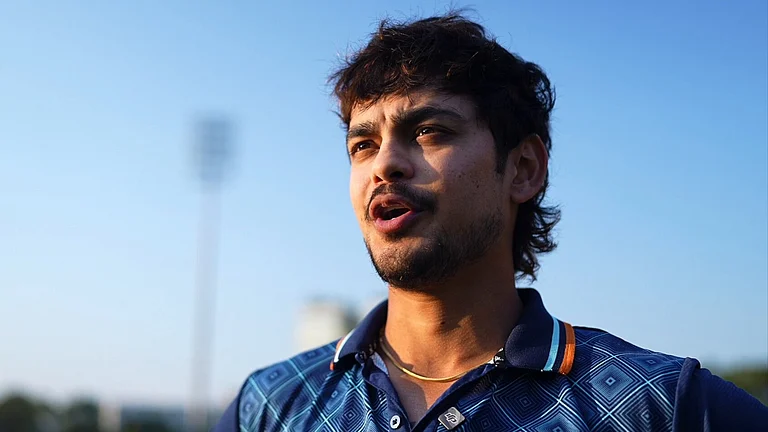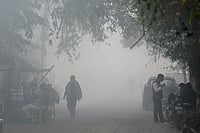Just over a month ago, as Karnataka chief minister Siddaramaiah deftly handled questions from well-known writers, journalists and activists at a conference his government was hosting, there came a poser for which he didn’t have much of an answer. It was the only point in the hour-long conversation when the CM had to stand up and calm down the audience who had risen up demanding to know why M.M. Kalburgi’s killers hadn’t been caught yet even two years after the Kannada writer-scholar was gunned down at his home.
The anger that is welling up isn’t something the Siddaramaiah government can anymore dodge, more so now after the shocking murder of Gauri Lankesh. The 55-year-old journalist was murdered on September 5 in an evening attack strikingly similar to the Kalburgi killing. “From day one of the Kalburgi murder till last week, we have got the same reply,” says K. Neela, writer and activist who had raised the question before the CM at the Bangalore meet. “Now there is Gauri. Prof Kalburgi was shot in the forehead; she was shot in the chest. That’s the only difference.” The same applies to the Dabholkar-Pansare murders that go back four years, she says. “Three governments—in Karnataka, Maharashtra and at the Centre—are answerable for these. If there has been any development in these cases, it’s because of the courts.”
So far, there have been no arrests in the Kalburgi murder case, but the CBI and the Maharashtra police, probing respectively the killing of Narendra Dabholkar (2013) and Govind Pansare (2015), have something to show, in terms of arrests or chargesheets. Of course, the Karnataka CID had made a startling discovery early on. “We were the ones who proved that all the (three) cases were linked,” says a senior Karnataka police officer, referring to their ballistics report that said the bullets used in all three murders came from the same two weapons. Since then, there hasn’t been much progress, though the CID says it is on the lookout for suspects.
Activists and writers, who have been pressing the government for swifter action, sense a poor coordination among the three probe agencies. “We had a feeling that maybe progress would have been better if there had been more collaboration, but the government’s stand was they have already taken the necessary steps,” says academic and writer Rajendra Chenni. “At least some arrests were made in Maharashtra. But why isn’t there such clarity here?”
Last month, as Kalburgi’s second death anniversary on August 30 approached, Siddaramaiah issued a statement saying that the probe is being fast-tracked and that the investigating teams were in touch with each other. “Both teams have found close links between the crimes committed in Maharashtra and in Karnataka. The motive behind the crime is ascertained as attack on intellectuals holding divergent views on matters of historical inquiry,” says Siddaramaiah. But the question that many, including the opposition, is pointing to is this: why has Karnataka’s Congress government been slow in bringing the culprits to book?
“We have been after the government but it all rings hollow,” says poet-playwright Chandrashekar Patil, who was a college-mate of Kalburgi’s at the Karnatak University in Dharwad. “Some of us feel that some unknown hand is preventing the right kind of probe.”
Kalburgi, a prolific writer and researcher of the 12th-century Vachana literature of Basavanna and the Lingayat sharanas, often rattled conservatives among the Lingayats with his work, as peers like Patil note. Back in the late 1980s, he was forced to recant his views following a controversy over his book Marga. “There was a direct attack on Kalburgi and ultimately he had to compromise on his position. But then, in the later years, he became really fierce in his expression,” says Patil. He didn’t hesitate to be iconoclastic and was also vocal about the difference between Veerashaivas and Lingayats though the terms have been used synonymously for long. That claim—that Lingayats are not Hindus—is also a fairly old one, and it’s much in discussion in Karnataka of late with a section of Lingayats demanding the status of a minority religion.
Gauri represented the same ideology as Kalburgi’s, says Neela, who is a senior member of the All India Democratic Women’s Association. It would be premature to draw conclusions about Gauri’s murder. Siddaramaiah, while setting up a special investigation team, made the observation that it appeared to be an organised crime. There is also the speculation that Gauri was likely getting some hate mail over her efforts towards bringing Naxals into the mainstream. Her brother, Indrajith Lankesh—the siblings have had their differences that led to them parting ways after initially running their father’s tabloid Lankesh Patrike together—has demanded a CBI probe into the murder of his sister.
A week ago, the Bombay High Court had passed another order seeking a probe into the role of organisations in killings of Dabholkar and Pansare. “...if there is an institutional and organisational backing, including funding from abroad, then the investigating agencies must inquire into all such means, funding and financial sources and other assistance, including the provision of weapons, and place before the court a report,” the order went. “We impressed upon both the investigating agencies that they should take these cases as a challenge as modern day criminals include those who do not commit crimes on sudden provocation or in a spate of anger but are systematically driven to commit such crimes at the behest of or on account of the advice or teaching and training, influence of somebody who is wedded to a philosophy of targeting the broad-minded liberals and bold enough to express their views and opinion, and if necessary ruthlessly eliminating them.”
Last year, the CBI, probing the Dabholkar murder, arrested Dr Virendra Tawde and named him as a conspirator in their chargesheet. Two others, Sarang Akolkar and Vinay Pawar, who have been named in the chargesheet, are absconding and the CBI this year announced a reward on information regarding the duo. Tawde, reports say, was allegedly associated with Hindu Janajagruti Samiti, a right-wing group.
Only one arrest was made in Pansare murder case—that of Sameer Gaikwad, who has been granted bail. The role of Sanatan Sanstha, of which Gaikwad was a member, has been alleged but the organisation has denied it. So far, no case has been made out against the Goa-based outfit though the families of both the victims say that the “role” of the organisation needs to be probed.
“These should be treated like terror cases because the motive is to spread terror. This point is understated,” says Hamid Dabholkar, son of Dr Dabholkar, who has been pursuing the matter for the past four years. “Whoever is behind the murder of Gauri— be it individuals or organisations—will not be declared by the police so soon. But if people who are raising voice for similar issues have been gunned down in similar manner, then it needs to be probed. Had the murderers been brought to book, such people would not have had the courage or audacity to do this again. The state and the police have failed miserably.”
Megha Pansare, daughter-in-law of Govind Pansare, recalls how Gauri had been a leading voice in various protests over the three assassinations. They had last met in Bangalore a few weeks ago when Megha was part of a delegation that met Siddaramaiah. “She was very concerned about the zero progress by the probe agencies in the Kalburgi case. She said they were going to organise protests in Banglore and that we will meet soon for the next joint action in this matter,” says Megha. “This is one more bid to silence the free voice of a sensitive and bold journalist in India.”
According to Chenni, this would be the question a common citizen would be asking: If some people can come and shoot a well-known face in Karnataka and go away, what about me?” That, evidently, is the question Siddaramaiah faces. And, it has to come up with answers. “Now, there is strong pressure upon the present government,” says Patil. “They must proceed with the right kind of investigation and come up with some kind of result. We are waiting with our fingers crossed.”
“If they can’t solve these murders and punish the killers, it’s their government that will be the victim,” says Neela. “The CM has said the killers will be found soon. We will wait and see and then intensify our campaign for justice.”
***
A Pattern To The Murders?
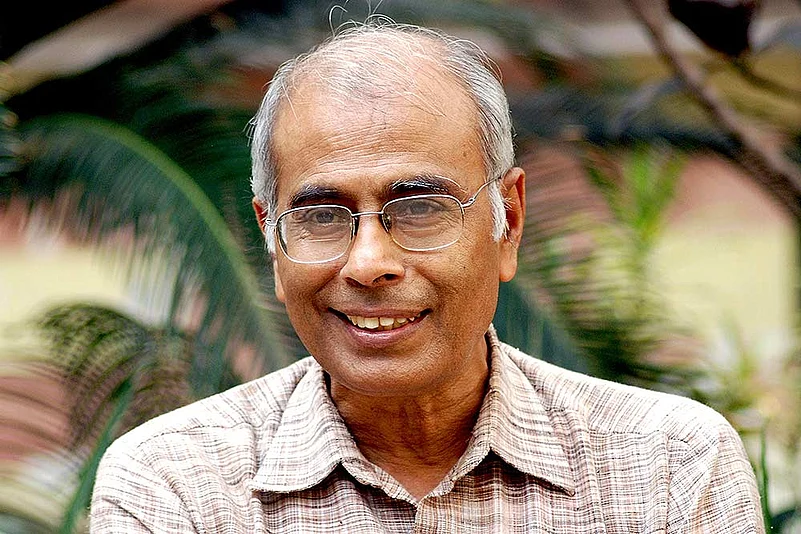
August 20, 2013, Pune
Narendra Dabholkar
Doctor and rationalist who campaigned against superstition and black magic, Dabholkar (65) was shot dead by two men on a motorcycle while out on a morning walk. The CBI arrested Dr Virendra Tawde in 2016, alleging motive was long enmity/hatred between two organisations. This year, it announced reward for information on Sarang Akolkar and Vinay Pawar, the two absconding accused named in the chargesheet.

February 16, 2015, Kolhapur
Govind Pansare
Communist Party of India leader Pansare (81) was shot outside his house while returning from a morning walk. Police arrested Sameer Gaikwad (out on bail now). Gaikwad was a member of Sanatan Sanstha, but the organisation has denied allegations linking it to the murder.
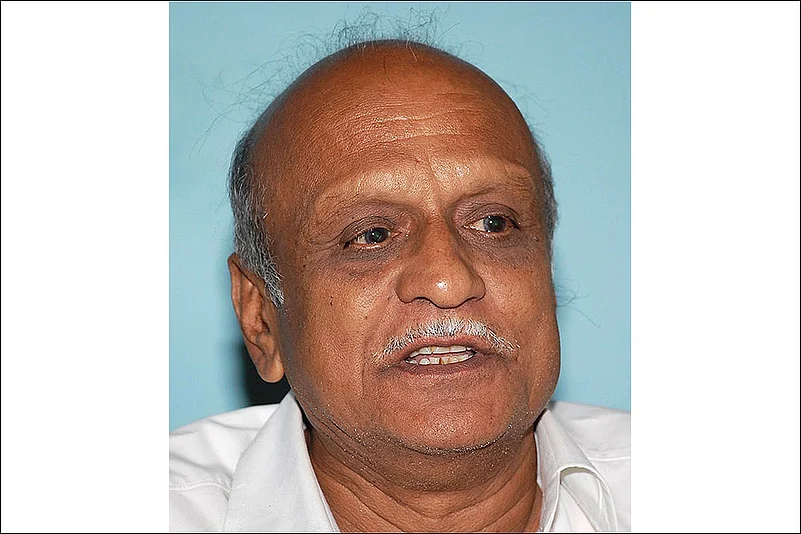
August 30, 2015, Dharwad
M.M. Kalburgi
Two motorcycle-borne men shot Kannada writer and scholar, Kalburgi at his doorstep around 8.30 am. Ballistics experts found link between weapons used to kill Kalburgi, Dabholkar and Pansare. But no arrests made yet. “Motive behind crime is ascertained as attack on intellectuals holding divergent views on matters of historical inquiry,” says Karnataka CM.
By Ajay Sukumaran in Bangalore with inputs from Prachi Pinglay-Plumber in Mumbai






